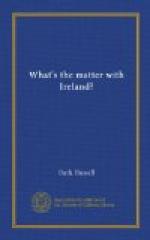Frank Walsh: “Look! There’s Bob Barton talking to his sister. Out there by the portrait of Queen Victoria—see that man in a green uniform. That’s Michael Collins of the Irish Volunteers and minister of finance of the Irish Republic. The very men they’re after.
“Is this a play? Or a dream?”
[Footnote 1. British propaganda, on the contrary, states that the Irish are not in the physical agony of extreme poverty. They are prosperous. They made money on munitions, and their exports increased enormously during the war.
“You could eat shell as easily as make it,” was one of the first parliamentary rebuffs received by Irishmen asking the establishment of national munition factories at the beginning of the war, according to Edward J. Riordan. Mr. Riordan is secretary of the National Industrial Development Association. This is a non-political organization of which the Countess of Desart, the Earl of Carrick, and Colonel Sir Nugent Everard are some of the executive members. It was not until 1916 that Ireland secured consideration of her rights to a share in the war expenditure. In that year, an all-Ireland committee called on Lloyd George. He said: “It is fair that Ireland, contributing as she does not only in money but in flesh and blood, should have her fair share of expenditure.... I should be prepared to utilize whatever opportunities we can to utilize the opportunity this gives you to develop Ireland industrially.” After persistent effort, however, all that the all-Ireland committee was able to get was five small munition factories. The insignificance of these plants may be realized from the fact that at the time the armistice was declared there were only 2,250 workers in them.
As to trade increase:—when I was in Ireland in 1919, the last export statistics given out by the government were for 1916. In 1914 exports were valued at $386,000,000; in 1916, at $535,000,000. But, according to the Board of Trade, prices had doubled in that time, so that if exports had remained stationary, their value should have doubled to $772,000,000.]
[Footnote 2. That England controls this industrial situation was made clear during the war. Then ship tonnage was scarce, and England’s regular resources of agricultural supply were cut off. So England called on Ireland to revert to agriculture. Ireland’s tillage acreage jumped from 2,300,000 in 1914 to 3,280,000 in 1918. This change in policy brought prosperity to some of the farmers, and Ireland’s bank deposits rose from $310,000,000 in 1913 to $455,000,000 in 1917. But England is reestablishing her former agricultural trade connections. According to F.A. Smiddy, professor of economics at University college, Cork, a return to grazing has already commenced in Ireland, and "prosperity” will last at most only two post-war years.]
[Footnote 3. British taxation saps Irish capital. The 1916 imperial annual tax took $125,000,000 put of Ireland and put back $65,000,000 into Irish administration. Irishmen argue that the excess might better go to the development of Ireland. Figures supplied Department of Agriculture, 1919.]




